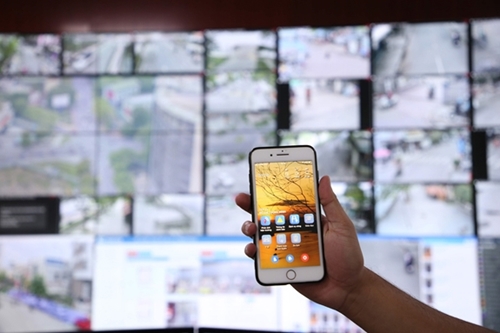The center was developed to monitor and handle transportation issues by monitoring and managing images to serve administrative needs. It uses images to manage the public transit system and monitor security and social order in central areas and relic sites. It also receives information and feedback to evaluate the quality of public administrative services as well as being able to receive and reply to tourist’s queries and complaints about problems during their stay in the locality.
Tran Tuan Ngoc, Deputy Director of Business Customer Center of the Business Solutions Corporation of the Military Industry-Telecom Group (Viettel), has given an interview to a reporter of the People’s Army Newspaper to help readers learn more about this model.
Reporter: It is known that smart city development is mostly based on the IT platform. As a leading business in Vietnam, what has Viettel done to apply IT solutions to the building of a smart city in provinces and cities in the country?
Tran Tuan Ngoc: Viettel has five years of experience in studying smart city building. We studied many effective smart urban area development models throughout the world and have applied modern technologies to building a model in Thua Thien-Hue province. Basically, it is built on a common platform with the participation of not only Viettel, but also other technology providers. Particularly, more than half of the smart services in Hue is provided by local businesses.
Reporter: Could you elaborate more on the process of building a smart city model in Hue?
Tran Tuan Ngoc: In the first place, the Chairman of the Thua Thien-Hue provincial People’s Committee Phan Ngoc Tho imposed detailed requirements for the model in the province. Based on the province’s requirements and the results of meetings between the locality and other technology partners, we were able to build a smart city that meets all of the demands of the local people. To achieve the goal, Viettel and Hue carefully surveyed the features of the locality and outlined a model that suits it. It is intended that this model can be applied to other cities.
    |
 |
|
At the Thua Thien-Hue Smart City Monitoring and Operation Center |
Reporter: After the nine-month operation, have smart technology solutions met all of the set requirements or do they need to be upgraded?
Tran Tuan Ngoc: Building a smart city is a long and continuous process, so we need more time to upgrade and adjust technology solutions to suit the reality.
Reporter: Some people said that smart city development program focuses on major domains, including smart transportation, smart healthcare, smart education, and environment. So what needs to be done to integrate all of the technologies into a model?
Tran Tuan Ngoc: At present, Viettel has developed this kind of model and applied it to Hue. We launched a platform to connect all of the cameras in the locality to an available IT system and allowed businesses to use our services. Viettel is also ready to provide this platform to other localities across the country. Particularly, the group has implemented the IOC (Intelligent Operations Center) Platform which collects and analyzes data. Viettel also provides other platforms that can connect to different applications.
Reporter: Hue attaches much importance to receiving citizens’ feedback. How should Viettel’s Hue – S application be developed to achieve the best results?
Tran Tuan Ngoc: To meet requirements of the province’s leadership, Viettel set a target to develop advanced, but easy-to-use technologies. Hue – S application is developed like a social network, so residents can use it easily. As a result, the application is widely used.
    |
 |
|
Hue - S application is more popular with local people |
Reporter: At present, many provinces and cities want to develop their smart urban areas. However, building infrastructure and a database using technology solutions is costly. What do you think about that?
Tran Tuan Ngoc: Regarding technology, smart city development programs may be costly. However, the problem can be solved if provinces and cities develop models that suit their own features. I think that they should consider technological issues and their urgent social problems while mapping out detailed development plans. In addition, they should divide up their investment portfolio into different stages, so as to ease the financial pressure while ensuring the effectiveness of the project.
Reporter: Could you tell us about any further implementation of the model in Hue?
Tran Tuan Ngoc: The smart city model in Hue has proved to be effective. However, both sides are coming up with approaches to secure the success, while applying more advanced technologies to deal with existing problems.
Reporter: Thank you very much!
Translated by Tran Hoai - Hai Yen